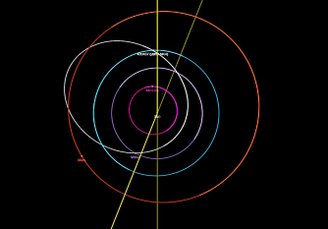On April 15 at 11:50 (Brasília time), The 610-meter-wide space rock, known as the 2013 NK4 asteroid, made its closest contact with Earth. According to NASA’s Jet Propulsion Laboratory (JPL), this is the smallest distance ever recorded in history between a potential “city-killer asteroid” and our planet: 3.2 million kilometers.
This range, equivalent to almost eight times the distance at the zenith of the Moon, was considered safe but “potentially dangerous” due to the object’s enormous size, twice that of Apophis, known as the “doomsday asteroid”. The proximity means 2013 NK4 will still be visible with an amateur telescope on the nights of April 16 and 17.
Although the massive rock has the potential to destroy a major city and cause serious environmental impacts if it hits Earth, this possibility is completely excluded from NASA’s calculations. The agency states that the asteroid will probably never come close to impacting our planet.
What type of asteroid is 2013 NK4?
Observations made by Goldstone, a radar system operated by JPL in the Mojave Desert, indicate that 2013 NK4 is not just a single asteroid but rather a contact binary, that is, two celestial objects that gravitate towards each other until they come into contact, resulting in He claims that he came out. elongated shape.
When it was discovered in 2013, the prediction of its current passage past Earth caused some concern among astronomers, mainly because of its size and because further close approaches would occur (the next approach will be in 2068). The disturbance soon disappeared when it was discovered that the object had a specific orbit and that it did not pose any risk to the planet..
According to EarthSky.org, 2013 NK4’s orbit around the Sun lasts 378 Earth days, but is slightly more elliptical than ours. The rock passes by Mars and then “plunges” between the orbits of Venus and Mercury. Asteroid passed by Earth at an impressive speed of 59,400 kilometers per hour.
How to observe 2013 NK4 from Earth?

Since 2013 NK4 will be most visible on the nights of April 16-17, it will be possible to observe it with an amateur telescope. To find your position in the night sky, you can consult the free online planetarium TheSkyLive.com.
To facilitate observation of the asteroid, the website EarthSky.org recommends using GoTo software for telescope control, which can arrange motorized mounts compatible with different manufacturers. The asteroid will appear on the telescope screen as a slow-moving point of light in front of the background stars.
Did you like the content? Follow all the astronomy news on TecMundo and get the opportunity to find out whether an asteroid will hit the Earth in 2029.
Source: Tec Mundo
I’m Blaine Morgan, an experienced journalist and writer with over 8 years of experience in the tech industry. My expertise lies in writing about technology news and trends, covering everything from cutting-edge gadgets to emerging software developments. I’ve written for several leading publications including Gadget Onus where I am an author.













